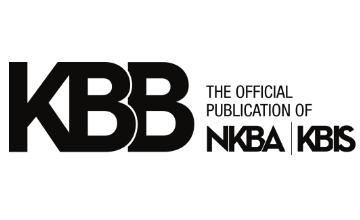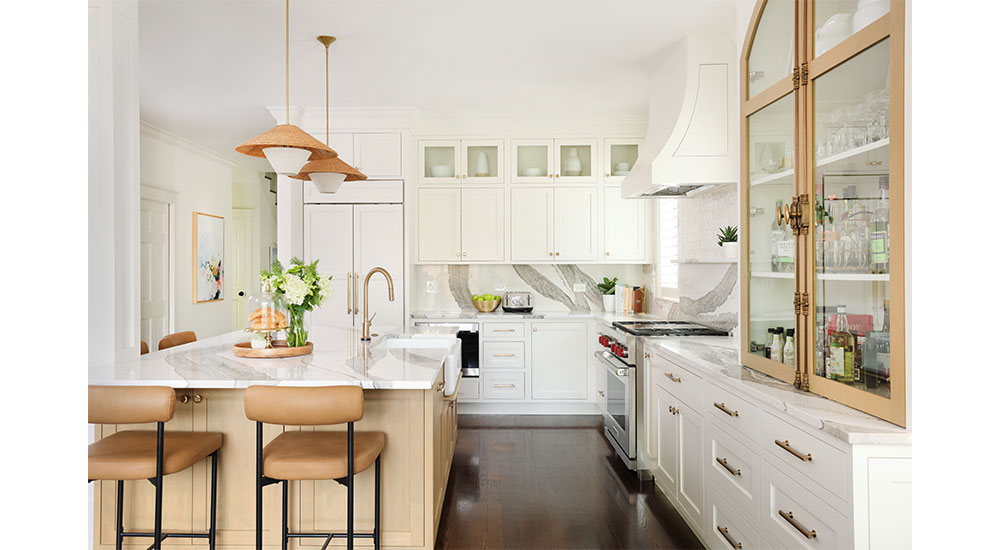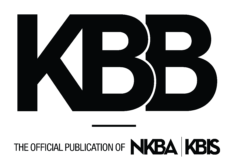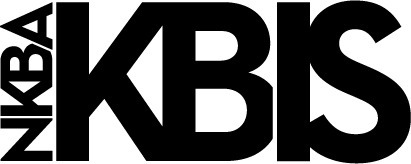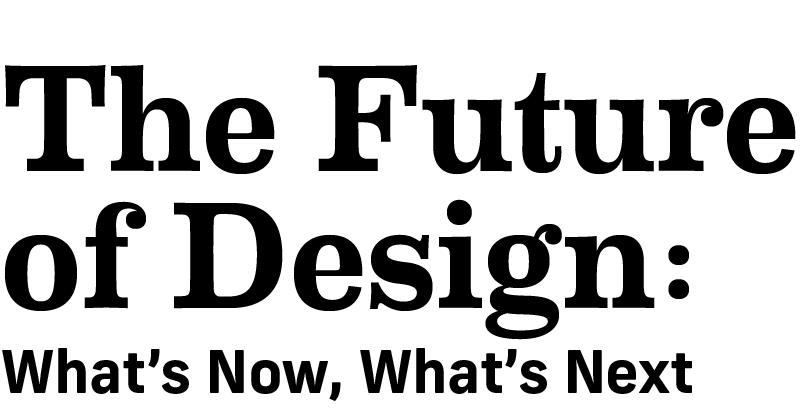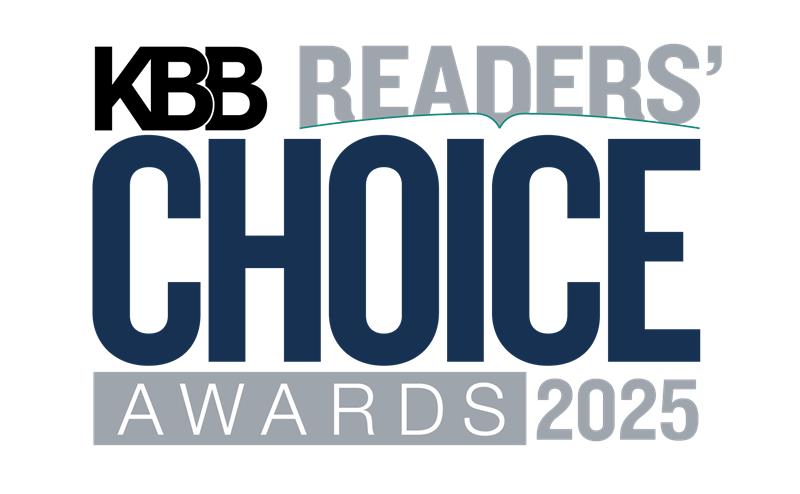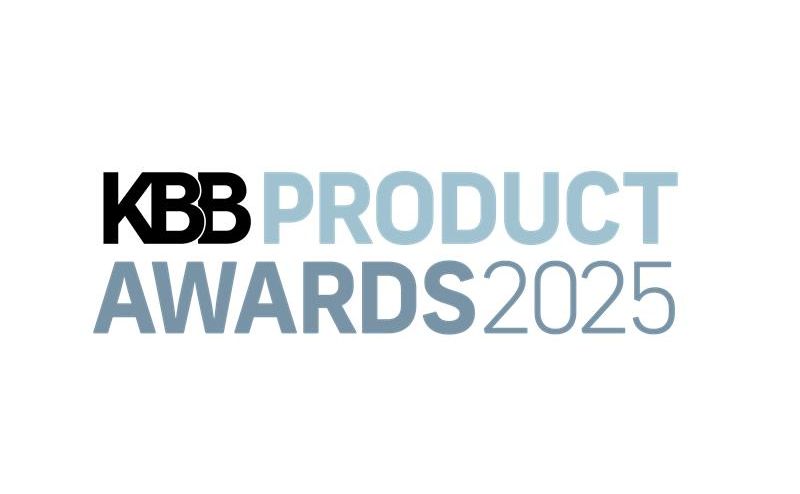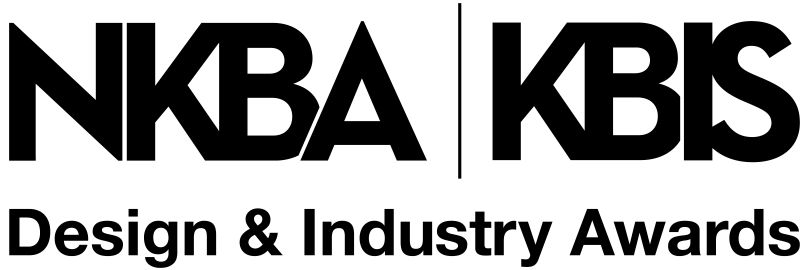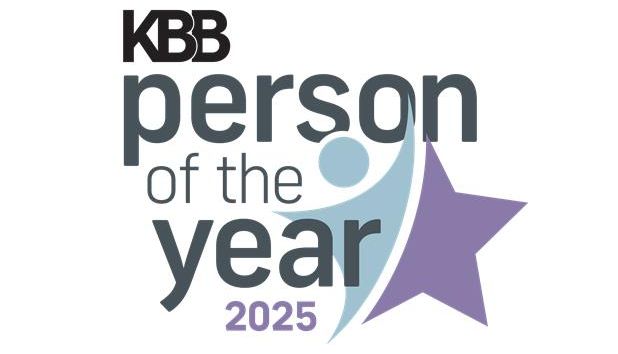The kitchen truly is the heart of the home, but without an appliance package that truly meets the needs of the people who live in it, function goes out the window. Homeowners who do not often cook in their kitchens may not need a lot of specialty appliances – just the basics. Others who prepare daily meals for their family could require a full suite of appliances with additional choices like a range with multiple functions. Those who consider themselves professional chefs who love to entertain on a regular basis will require all the bells and whistles – from wine refrigeration to drawers for warming and food preservation.
Above photo: Jackie Jensen of Normandy Design Build Remodeling chose white-painted and stained-alder cabinets for this kitchen, which also feature a paneled Sub-Zero refrigerator, a Cove dishwasher with a decorative panel, a stainless-steel Wolf range, and Sharp microwave and a Best hood insert.
Photo credit: Katrina Wittkamp
The essentials will differ for various clients, and it is up to a designer to determine what makes the most sense. In this survey, we delve into all things kitchen appliances, including popular colors, smart options, fuel choice, specialty selections and options for small kitchens.
Form & Function
When it comes to the most popular color choice for today’s kitchen appliances, stainless steel comes in at the top spot at 81.9%. Black and white come in much farther down the list at 9% and 4.5%, respectively. Other answers included green, various colors for glass panels and wood-paneled appliances.
“The range is often a popular appliance to showcase a pop of color,” said Jackie Jensen, a designer with Normandy Design Build Remodeling in Hinsdale, Ill. “Depending on the layout and size of the kitchen, it can easily become a striking focal point in the space.”
Stainless steel makes sense as the most coveted color for kitchens with paneled or built-in appliances, which are becoming more popular – albeit maybe not as quickly as we thought. In our survey 13% of respondents said all their kitchen projects included built-in or paneled appliances, and 13% said none of them did.
“Clients appreciate the seamless, furniture-like paneled appliances create in open-concept kitchens, where integration and flow are critical,” said Jerel Lake, owner of Atlanta-based Lakehaus Designs. “This also allows for a more timeless design that makes the appliances a part of the overall design aesthetic.”
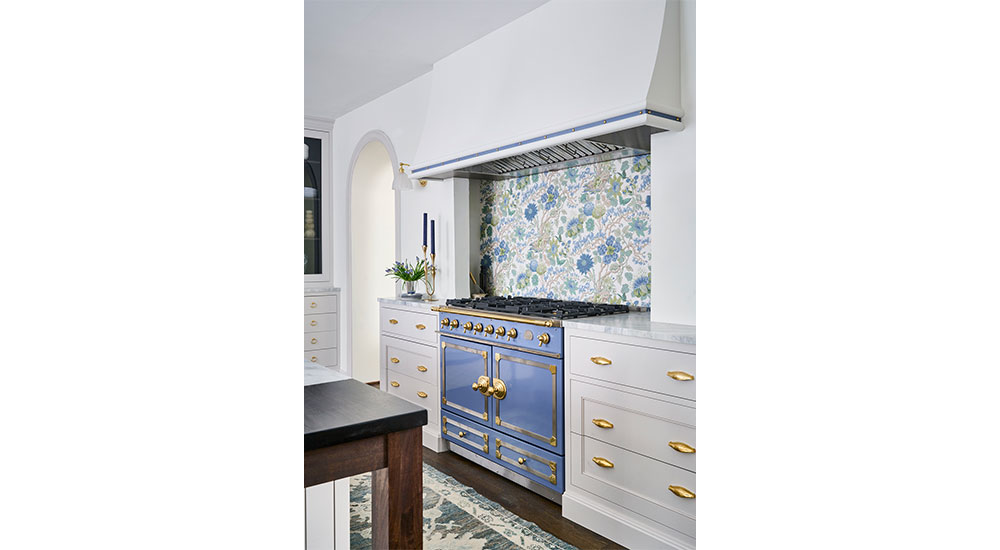
Jerel Lake of Lakehaus Designs chose a La Cornue range in Province Blue for this kitchen to make a statement and coordinate with the wallpaper backsplash. The large hood was created to match the color of the walls, and an accent band to match the range color and brass nail heads were added to tie the two units together in a subtle way. Photo credit: Marc Mauldin
Professional- and chef-grade appliances are slowly gaining traction in our industry, with 16.6% of all projects in the last year incorporating those and 8.3% of them not incorporating them at all.
In terms of range fuel choice, which we have asked out in our last three appliance surveys, dual fuel is number one at 41.9%, and induction is beating gas (21.3%) for second place at 23.9%.
“Dual fuel has been the most requested configuration in the past year because clients love the precision of a gas cooktop paired with reliable baking of an electric oven,” said Lake. “It isn’t the greenest choice because it still burns gas, so if sustainability is a priority, induction with an electric (often convection) oven generally delivers the lowest operational footprint.”
Playing It Smart?
Technology in the kitchen is a mixed bag these days. Younger generations more familiar with its benefits and the way it works are all in. For middle-aged and older clients who may not be as knowledgeable about smart technology, it is less of a priority. Despite the generation, the need for these features in the kitchen is unique to each homeowner’s needs.
In our survey, the most popular smart appliance option over the last year is remote on/off control at 42.4%; apps that adjust cooking times and temperatures came in at a close second at 41.7%. Other notable features include automatic service alerts, voice control of appliances, refrigeration that determines food freshness and applications that can change the refrigeration temperature. Ranges and hoods that are linked via smart tech was one of the write-in answers.
“While most of my clients aren’t requesting smart technology just yet, the few who do are looking for features like motion-sensor faucets and Wi-Fi connectivity,” said Jensen. “These options stand out because of the added convenience and ease they bring.”
Choices for Smaller Kitchens
Not all spaces are equipped for standard-size appliances – let alone two of one item as seen in larger, chef-style kitchens. Those with less square footage still have their requirements, and it is on the designer to suggest solutions will meet those needs.
Our survey reports the most popular of those solutions are narrow refrigeration columns (38.9%), dishwasher drawers in lieu of a full unit (36.6%), narrow dishwashers (35.1%) and refrigeration drawers in place of a standard-size fridge (29.8%). Other choices include narrow ranges and ovens, two-burner cooktops and on-the-counter dishwashers.
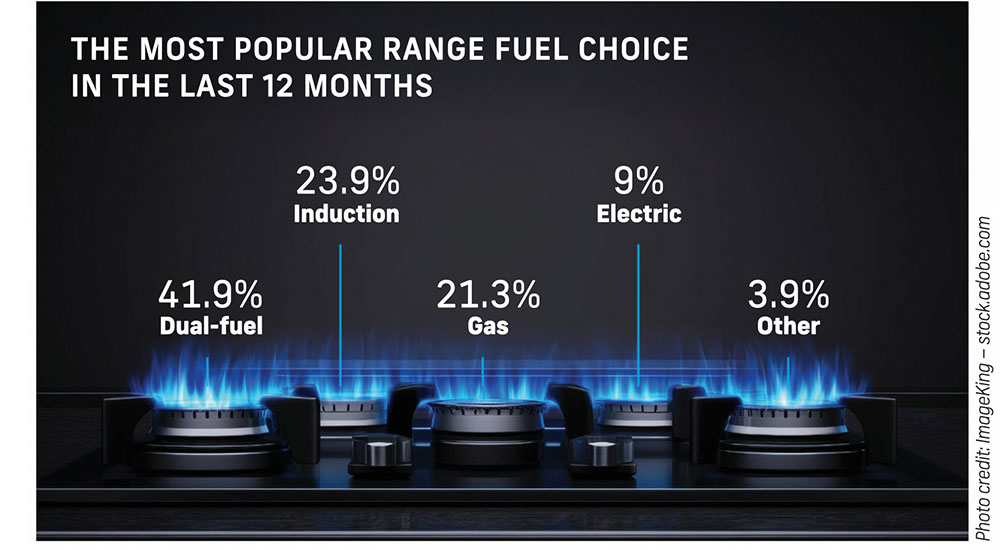
A Range of Specialties
Despite a kitchen’s size, some homeowners’ wish list items include specialty appliances and features. The omission of those could be a deal breaker for a successful project. Topping our list over the last year is wine/beverage refrigeration at 82.5%, with microwave drawers and dishwashers with adjustable racks coming in at second and third place with 64.9% and 53%, respectively.
Other noteworthy specialty appliance items include fingerprint-proof finishes, ranges with double ovens, built-in coffee makers, warming drawers, craft ice makers, freezer-to-refrigeration conversion, chargeable/wireless small appliances, food preservation drawers, induction burners under the countertop and double microwaves.
Specific to the oven/range, today’s clients want something that serves more than one purpose. According to our survey, the most popular function for the main cooking appliance over the last 12 months has been convection at 79.6%. Air fry was second (57.2%), and steam was third (46.7%). Other choices included a warming drawer, griddle, power burner, grill, sous vide, toaster, slow cook and rotisserie.
Tariff Impact
When asked if the current situation has influenced designers’ appliance choices for their clients’ kitchen project thus far, we got mixed answers. For those who have been impacted by the tariffs – potential or actual – some say because of those, consumer confidence has waned. Some clients are postponing projects, and others are holding back on larger purchases and downgrading their appliance choices.
Designers are opting for appliances that are either made in the U.S. and/or are not subject to U.S. tariffs and those that stand the test of time, meaning they do not have to be replaced as often as others. According to one respondent, anything he can do to help his clients avoid unnecessary costs and delays gives them one less thing to worry about, which is priceless.
“Tariffs have influenced our appliance selections, particularly when it comes to mid-range brands,” said Lake. “Some clients are shifting to U.S. or European manufacturers where pricing has been more stable. We’ve had to be proactive in managing expectations on lead times and budget impacts.”
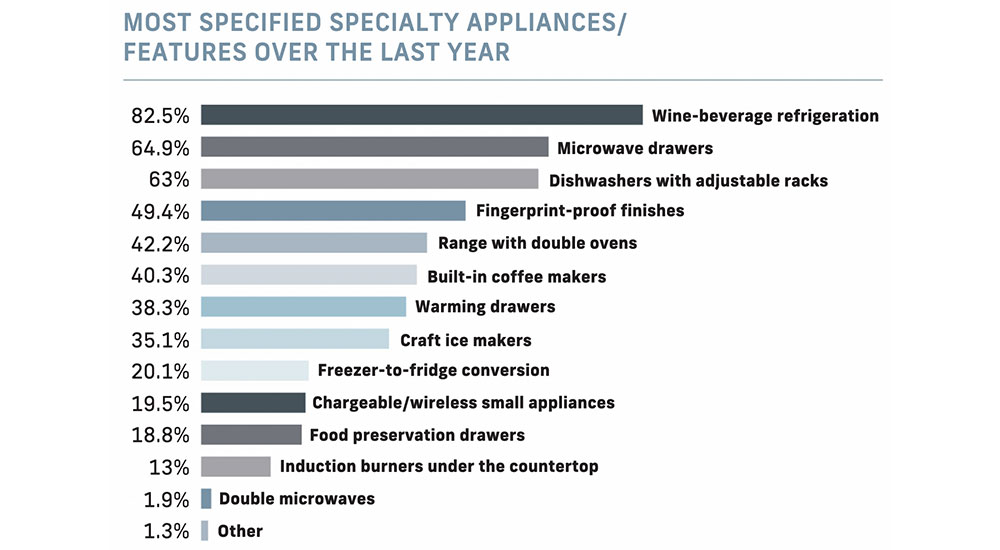
Appliance Inspiration
While visiting KBIS 2025 and other industry shows over the last year, our respondents saw several appliance innovations they hope gain traction. The most mentioned was induction cooktops under the countertop, which is somewhat related to wireless charging integrated into the countertop. In terms of induction cooking, Lake was impressed by the advancements he saw at KBIS 2025, including integrated ventilation options that eliminate the need for a separate hood.
Other offerings mentioned in our survey and throughout this article include refrigeration units that can switch to freezer mode, art panel refrigeration doors, steam ovens, dishwashers with adjustable racks and double ovens. Diving deeper into innovation, our respondents noted a walk-in cold pantry, countertop craft ice machines, built-in filtered water dispensers, vacuum-sealing technology and control knobs in with Spanish and braille operating instructions.
Bye, Bye, Bye, Bye-Bye
Although it may fill a need in some kitchens, one element we are eager to bid adieu is the over-the-range microwave. Speed ovens are one replacement, and 44.5% of our respondents said they did not use the antiquated feature in any of their projects during the last year.
“When kitchen space is limited, I typically plan for an over-the-range micro hood to maximize storage elsewhere,” said Jensen. “If space allows, I prefer tucking the microwave into a base cabinet, which keeps it out of sight and makes it easy for kids to heat up a quick snack safely.”
Lake says most of his clients prefer a microwave drawer, a small microwave hidden in an appliance garage or a wall/speed oven combination, which he says streamlines cooking zones and frees up countertop space.
As soon as one design element in the kitchen wanes in popularity, another is introduced to the market with bravado. It’s not always about the trends but rather what your individual client’s needs are. What may be super passe to one homeowner may be just the ticket with another. It’s up to you to discover that balance.
